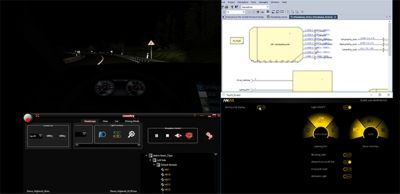-
United States -
United Kingdom -
India -
France -
Deutschland -
Italia -
日本 -
대한민국 -
中国 -
台灣
-
Ansys s'engage à préparer les étudiants d'aujourd'hui à la réussite, en leur fournissant gratuitement un logiciel de simulation.
-
Ansys s'engage à préparer les étudiants d'aujourd'hui à la réussite, en leur fournissant gratuitement un logiciel de simulation.
-
Ansys s'engage à préparer les étudiants d'aujourd'hui à la réussite, en leur fournissant gratuitement un logiciel de simulation.
-
Contactez-nous -
Carrières -
Étudiants et universitaires -
-
S'inscrire -
Déconnexion -
Espace client -
Support -
Communautés partenaires -
Contacter le service commercial
Pour les États-Unis et le Canada
+1 844.462.6797
-
ANSYS BLOG
December 11, 2019
Designing Headlamps to Win the IIHS Top Safety Pick
We’ve all seen the commercial: A car speeds across a highway as a voice says, “IIHS Top Safety Pick.” To a consumer, that’s a stamp of approval that says this purchase is the safest option.
To an engineer the Insurance Institute for Highway Safety (IIHS) is an independent, non-profit organization that aims to reduce motor vehicle deaths and injuries. Their ratings could make or break an automotive design.
Headlamps are a particularly difficult piece of equipment to optimize for Top Safety Pick testing because the assessment is unique and has been recently updated.
Additionally, the tests are done on the actual car — after the design process. As a result, if the headlamp rating is unsatisfactory, there isn’t much a company can do to fix the vehicle before it gets to market.
Therefore, to optimize these designs for the safety tests, engineers need simulation tools that can predict ratings early in the development process — when a headlamp can be optimized quickly and affordably.
A high IIHS rating is a stamp of approval to consumers. However, reaching this high bar can be a challenge for engineers designing headlamps.
The Challenges to Predict IIHS Ratings for Headlamps
Just because a headlamp meets federal safety standards doesn’t mean it will receive a good ranking from the IIHS. That is because their testing process is unique.
Traditionally, it can be challenging to simulate IIHS headlamp testing.
But it can be done using Ansys VRXPERIENCE.
The rating is based on sensor readings and numerical evaluations that are performed under dynamic conditions and five driving trajectories.
At the end of each trajectory, illuminance sensor data is collected and post-processed into a demerit value and rating.
Because the position between the sensor and headlamp is consistently changing, it would take complex simulations to replicate the test digitally. On top of that, engineers would have to recreate the environmental conditions of the test and the car’s pitch, roll, yaw, steering wheel angle and adaptive front lighting systems.
How to Simulate IIHS Headlamp Testing
Not many engineers have the equipment to simulate these tests. Those who do would generate a large amount of data that would be difficult to process into demerit values and IIHS ratings.
Engineers can use the physics-based simulation software Ansys VRXPERIENCE to recreate IIHS Top Safety Pick testing and driving conditions. They are able to import vehicle dynamics models into the software to accurately predict a car’s behavior.
A virtual illuminance sensor within VRXPERIENCE can be connected to Ansys SCADE to gather data through each trajectory. Once the data is collected, the software will automatically calculate demerit vales and ratings as defined by IIHS criteria.
Engineers can then iterate their designs early in the development cycle until they are confident that they will outperform the competition on test day.
A headlamp simulation in Ansys VRXPERIENCE.













